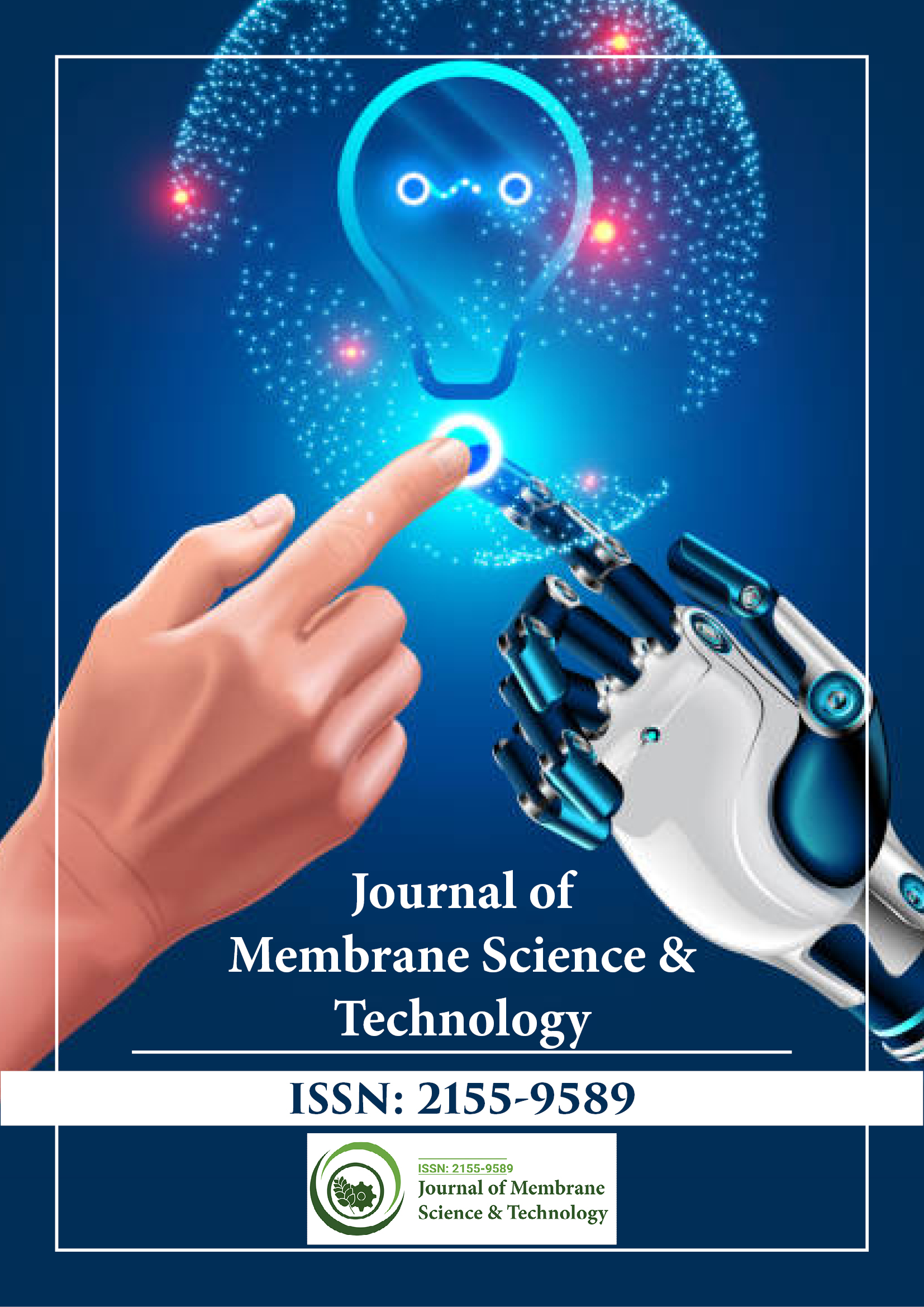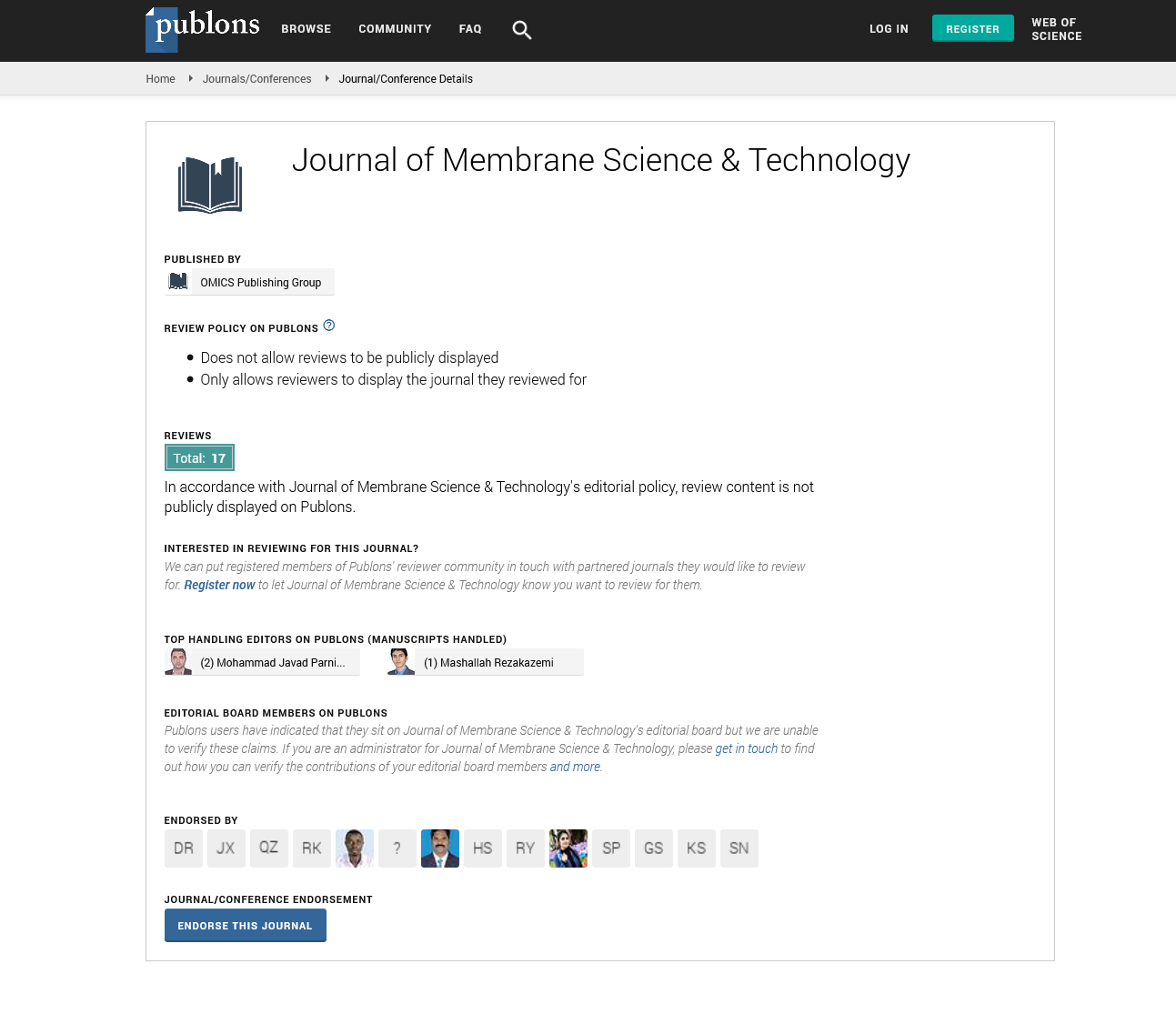Indexed In
- Open J Gate
- Genamics JournalSeek
- Ulrich's Periodicals Directory
- RefSeek
- Directory of Research Journal Indexing (DRJI)
- Hamdard University
- EBSCO A-Z
- OCLC- WorldCat
- Proquest Summons
- Scholarsteer
- Publons
- Geneva Foundation for Medical Education and Research
- Euro Pub
- Google Scholar
Useful Links
Share This Page
Journal Flyer

Open Access Journals
- Agri and Aquaculture
- Biochemistry
- Bioinformatics & Systems Biology
- Business & Management
- Chemistry
- Clinical Sciences
- Engineering
- Food & Nutrition
- General Science
- Genetics & Molecular Biology
- Immunology & Microbiology
- Medical Sciences
- Neuroscience & Psychology
- Nursing & Health Care
- Pharmaceutical Sciences
Commentary - (2025) Volume 15, Issue 1
Microfiltration: A Critical Technology for Purity and Precision
Kristin Gravees*Received: 31-Jan-2025, Manuscript No. JMST-25-29270; Editor assigned: 03-Feb-2025, Pre QC No. JMST-25-29270 (PQ); Reviewed: 17-Feb-2025, QC No. JMST-25-29270; Revised: 24-Feb-2025, Manuscript No. JMST-25-29270 (R); Published: 03-Mar-2025, DOI: 10.35248/2155-9589.25.15.409
Description
Microfiltration is a pressure-driven membrane process used to separate microscopic particles and microorganisms from fluids, primarily water or various process liquids. It is a critical filtration technique widely applied across diverse industries including food and beverage, pharmaceuticals, biotechnology, chemical processing and water treatment. The defining characteristic of microfiltration is the pore size of the membranes used, typically ranging from 0.1 to 10 micrometers. These membranes act as a barrier, permitting smaller molecules such as water and certain dissolved solids to pass through while retaining suspended solids, bacteria and larger particulates. The result is a purified liquid stream and a concentrated retentate, both of which may be further processed or disposed of depending on the specific application.
Unlike other forms of membrane filtration such as ultrafiltration, nanofiltration or reverse osmosis, microfiltration operates at relatively low pressures, usually below 2 bar (30 psi). This low-pressure requirement translates into lower energy consumption and operating costs, making microfiltration an economically attractive option for many continuous or batch liquid processing needs. Additionally, due to the mechanical strength of microfiltration membranes and the straightforward system design, maintenance requirements are generally minimal and system durability tends to be high, further reducing lifecycle costs.
In the food and beverage industry, microfiltration plays a significant role in ensuring product safety and quality. It is commonly employed for the clarification of fruit juices, wine, beer and dairy products. In dairy applications, for instance, microfiltration is used to remove bacteria and spores from milk while retaining key proteins, thereby extending shelf life without the need for heat treatment. This is particularly important in the production of fresh cheeses and other products where traditional pasteurization would adversely affect flavor or texture. The nonthermal nature of microfiltration preserves organoleptic qualities and nutritional value, providing a competitive advantage in high-quality product segments.
In the pharmaceutical and biotechnology industries, microfiltration is an essential tool for achieving sterility in liquid formulations. The ability to remove bacteria without compromising product integrity is particularly valuable in vaccine production, injectable drug formulation and fermentation processes. Filtration systems must meet stringent regulatory standards such as those set by the U.S. Food and Drug Administration (FDA) or the European Medicines Agency (EMA) and microfiltration membranes are often validated for bacterial retention performance using specific challenge tests, such as those involving brevundimonas diminuta, a bacterium known for its small size. These standards ensure that products processed with microfiltration meet the required sterility assurance levels without chemical additives or extreme physical treatments.
Another key area where microfiltration is indispensable is in water treatment and environmental applications. In municipal water treatment, microfiltration is utilized for removing pathogens, algae, and turbidity before disinfection stages. In wastewater treatment, it serves as a barrier in Membrane Bioreactors (MBRs), which combine biological degradation processes with membrane separation. MBRs offer significant advantages over conventional treatment methods, including smaller footprint, better effluent quality, and higher resistance to variable influent loads. Microfiltration membranes in these systems help achieve consistent removal of suspended solids and bacteria, allowing for safe discharge or water reuse in industrial or agricultural contexts.
The design and materials of microfiltration membranes are central to their performance and application suitability. Membranes can be made from polymers such as Polyethersulfone (PES), Polypropylene (PP) or Polyvinylidene Fluoride (PVDF) each offering unique properties in terms of chemical resistance, temperature tolerance and mechanical strength. Ceramic microfiltration membranes are also available, offering superior durability and resistance to harsh cleaning protocols, although at a higher initial cost. Membrane modules are configured in various forms including flat sheet, hollow fiber, spiral wound and tubular designs. The choice of configuration depends on the characteristics of the feed stream, fouling potential and the desired operational parameters such as flow rate and pressure drop.
Fouling remains one of the principal challenges in microfiltration processes. Fouling occurs when particles accumulate on the membrane surface or within its pores, leading to decrease permeate flow and increased energy demand. Strategies to mitigate fouling include pre-treatment of feed water, periodic back flushing, use of Cleaning-In-Place (CIP) systems and chemical cleaning using appropriate agents. Membrane manufacturers continually innovate to produce membranes with hydrophilic coatings, smooth surfaces and optimized pore structures to reduce fouling tendencies and extend membrane life.
Conclusion
As global emphasis on sustainability and water reuse increases, the importance of microfiltration is expected to grow. Whether in producing clean drinking water, ensuring the safety of pharmaceuticals or maintaining the quality of consumable goods, microfiltration stands as a versatile and dependable technology. It balances performance with cost-effectiveness and aligns well with modern industry demands for safe, clean and efficient liquid processing. The continued evolution of membrane materials, module designs and system integration strategies ensures that microfiltration will remain a cornerstone in the pursuit of purity and precision across a broad spectrum of critical industries.
Citation: Gravees K (2025). Microfiltration: A Critical Technology for Purity and Precision. J Membr Sci Technol. 15:409.
Copyright: © 2025 Gravees K. This is an open-access article distributed under the terms of the Creative Commons Attribution License, which permits unrestricted use, distribution, and reproduction in any medium, provided the original author and source are credited.

